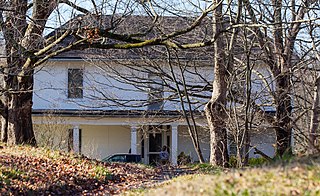
Croom is an unincorporated community and census-designated place in Prince George's County, Maryland, United States. As of the 2010 census it had a population of 2,631. Croom largely consists of former tobacco farms and forests converted to Washington bedroom subdivisions such as nearby Marlton. The main part of Patuxent River Park is in Croom.

Dill Farm is a historic farm located off Steen Road in Shawangunk, New York, United States. It was first established by the Dill family in the 1760s and remains in use today.

Meadow Farm is a historic farm and estate in Henrico County, Virginia. It is best known for its role in Gabriel's Revolution. The main farmhouse was built in the late eighteenth century and is a well preserved example of small Virginia plantations of the time. It was listed in the National Register of Historic Places in 1974. The estate is now owned and operated by Henrico County as the Meadow Farm Museum.

Zehmer Farm is a historic home and farm complex located near McKenney, Dinwiddie County, Virginia. The farmhouse was built about 1905, and is a one-story, frame L-shaped dwelling with a broad hipped roof and wings added to both sides. Also on the property are a collection of outbuildings and farm structures – including animal shelters, corn crib, flue-cured tobacco barns, dairy barn and milk houses, and the sites of tenant houses, a butcher house, fire-cured tobacco barns and a sawmill.

The Jones Farm is a historic tobacco plantation house and farm located near Kenbridge, Lunenburg County, Virginia. It was built about 1846, and is a two-story, three bay, frame I-house with a rear ell dated to about 1835. It is sheathed in original weatherboard and has a side gable roof. It features a front porch with Greek Revival style characteristics. Also on the property are the contributing smokehouse, ice house, granary, storage barn, tobacco storage facility, dairy stable, corncrib, two chicken coops, five tobacco barns, three tenant farmhouses, and the sites of a well house and tool shed.

Obediah Winston Farm is a historic tobacco farm complex and national historic district located near Creedmoor, Granville County, North Carolina. The farmhouse was built about 1855, and is a two-story, five bay, Greek Revival style heavy timber frame dwelling. Also on the property are the contributing log outbuilding, slave house, potato house, stable, smokehouse, packhouse, tobacco barn, and tenant house.

Catalpa, also known as Wallace Farm, is a historic farm located southeast of Greenfield, Iowa, United States. It is associated with Henry Cantwell Wallace, who owned and operated the influential agricultural publication Wallace's Farmer, and served as U.S. Secretary of Agriculture (1921-1924). It is also associated with his son Henry Agard Wallace, who followed his father at the newspaper and served as U.S. Secretary of Agriculture (1933-1940), Vice President of the United States (1941-1945) and U.S. Secretary of Commerce (1945-1946). He was the Progressive Party candidate for president in 1948. This was one of several farms owned by the Rev. Henry Wallace, Henry Cantwell's father. It was acquired by the family in 1877, and it was operated by a tenant farmer until Henry Cantwell took it over. His son Henry Agard was born here in 1888. After five years Henry Cantwell returned to his studies at Iowa State University in Ames and the family left the farm at that time. It was listed on the National Register of Historic Places in 1974. The designation includes the farmhouse and outbuildings, which are modest frame structures with gable roofs, and a 200-acre (81 ha) plot of farmland. The house and barn were built before the Wallace's moved here in 1887.

The Maple Dean Farm is a historic farmhouse in Shelbyville, Tennessee, U.S.. Built in 1886 on a farm established in 1819, it was designed in the Eastlake architectural style. It became a century farm in 1976, and it was listed on the National Register of Historic Places in 1976.

Ewing Farm is a historic farmhouse three miles away from Lewisburg, Tennessee, US.

Wessyngton is a historic mansion on a former tobacco plantation in Cedar Hill, Tennessee, U.S. It is listed on the National Register of Historic Places.

The Walton-Wiggins Farm is a historic farmhouse in Springfield, Tennessee, U.S..
Murray Farm is a historic farmhouse in Readyville, Tennessee, U.S..
Riverside Farm, also known as the Pierce-Randolph Farm, is a historic farmhouse in Walter Hill, Tennessee, U.S..
The William B. Jordan Farm is a historic farmhouse in Eagleville, Tennessee, U.S..

The Brown-Chenault House, also known as Campbell Farm, is a historic house in Castalian Springs, Tennessee, U.S..
Greenfield, also known as the David Chenault Home, is a historic farmhouse in Castalian Springs, Tennessee, U.S..
The James B. Jameson House, also known as the Jameson-Harsh House, is a historic house in Gallatin, Tennessee, U.S..
The Rascoe-Harris Farm, also known as the Anderson Farm or Maplewood Farm, is a historic farmhouse in Sumner County, Tennessee, U.S.. It was built circa 1824 for Thomas Howell Rascoe, a farmer who owned six slaves in 1830. After the American Civil War of 1861–1865, some slaves became tenant farmers. The farm was purchased by Green B. Paris in 1891.
Oakland is a historic mansion on a farm in Gallatin, Tennessee, U.S.. It was built circa 1850 by John Fontville, who also built the James B. Jameson House in Gallatin and Greenfield in Castalian Springs. The original owner, Daniel Wade Mentlo, was a physician who owned 23 slaves in 1850.
The Rucker-Mason Farm is a historic farmhouse in Cannon County, Tennessee, U.S.. It was built circa 1800 for Gideon Rucker. It was acquired by his brother, Bennett Rucker, in 1817. By 1840, he owned 14 slaves. The farm remained in the Rucker family until 1902.










